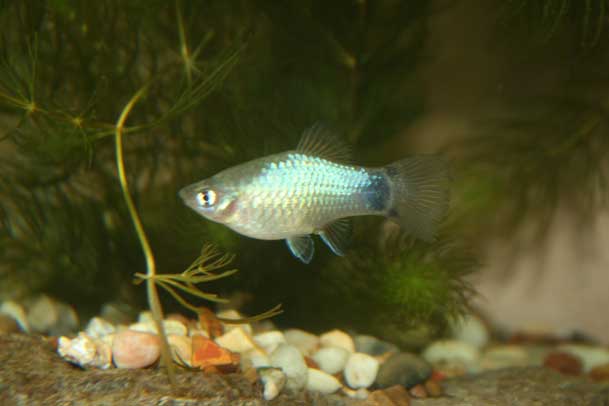Once again the urge to create a new fish struck. So, today, while going through our blue mickey mouse maculatus, I imagined the iridescent blue of the platies on a swordtail. I selected a few female platies and, after some thought, picked a male swordtail to father the new color strain. Which sword and why did I have to ponder it? I picked a black swordtail male that had iridescent green-blue scales. Typically, I wouldn’t use such a male as black swordtail breeder because I prefer the jet black fish in that strain and consider the iridescence a fault to breed against. But, he was perfect for this application since he already had genes for iridescence.
So, the chosen male sword got his females. In about a month I’ll purge the first batch of fry these females drop. Their next batches of fry should have some sword/platy hybrids. They will be easy to spot as they mature. They’ll be longer and larger than platies and the males will sport short swords. I expect a variety of colors. I’ll pick fish of both sexes with the best iridescent blue to produce an F2 generation. If I get nothing with blue, I’ll pick any iridescent fish. Absent those, I’ll throw all the hybrids together and hope for more luck in the next generation. In any event, eventually I’ll get a blue iridescent sword. From there I’ll simply raise tons of offspring and select only the best of each generation until I get the perfect blue iridescent sword.
I’ll keep you posted on my progress.



Richard ST says
Good Luck. Have been trying for years to get a good blue. Didn’t go the black route but did try the blue platy. Couldn’t get the male sword to breed with her. Haven’t given up. Would love to be kept updated. This has also been my dream. The bluest swordtail
charles says
Richard, I’ve had good luck getting sword/platy/variatus hybrids by using 6 males with about 20 females. I have found male platies and variatus are more eager to mate with female swords than the other way around, but do still get hybrids with male swords. I think the key is using multiple males with multiple females. As an interesting aside, male hybrids are often very large but have short swords.
Richard says
I agree with you. Unfortunately, the females I have don’t like male platys or variatus! The lyretails (half green lemons, half blue) may think differently when older but their mom don’t like males in general. My blue male was more experienced and quite frankly, i was surprised he got to mate. She killed one male platy and beat up two younger variatus. What I don’t like is that the platy’s have very short bodies. I’m thinking perhaps a HF Blue Platy with a blue/green montezuma I’ve seen offered on Aquabid. That could compenstate for tail and body. What think you?
charles says
It’s worth a try. I’ve seen some montezumas with a lot of blue. Nothing ventured, nothing gained. I have a small group of swords I call “red & blue.” If I can improve them, I’ll mate them with blue platies to see what happens. Let me know how things go.
Richard says
It’s always worth a try. But I don’t want to compromise size and genetics plays a much bigger part then the eye and mind dictates. I think we have something here, though. The monte’s have the size, tail length and some color to offer, while the platy’s have the color – period. I will try this direction and if you do, let me know what you get.
charles says
Keep me posted on your progress and I’ll do the same for you. What I call
“emergent characteristics” often pop up when making crosses. Our Blue Opal
Platy is an example. I was trying to introduce hifin into our Neon Marigold
Platy strain by crossing them to a Marigold Hifin Variatus. In the F2 I got
some fish with yellow fins and pale blue bodies. This was completely
unexpected, an emergent characteristic. Neither parent showed anything
similar in coloration. Apparently, two genes, one from each parental lines
was necessary for the new color. This is similar to the development of Red
Platies and Red Swords. Swords contributed the gene for red and the platies
the gene causing the red to spread over the entire body and fins. By the
way, the Blue Opals are now one of our most popular strains.